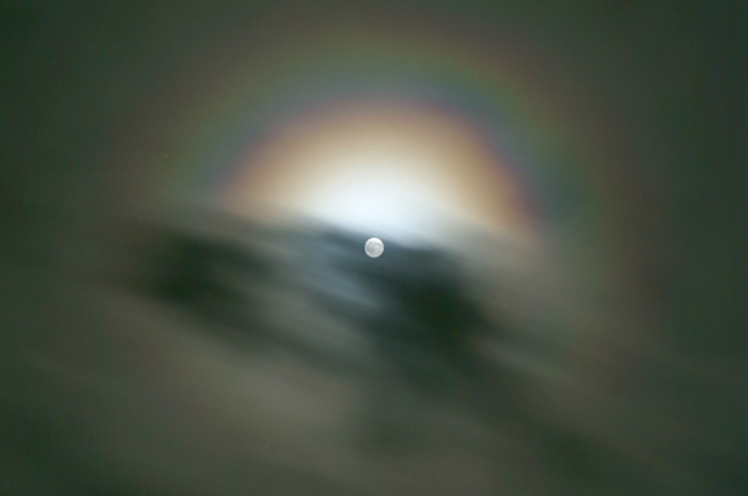Lunar Corona
Lunar Corona: A Phenomenon of Rings around the Moon
Have you ever noticed a mesmerizing sight of rings around the moon on a clear night? This enchanting phenomenon is known as a lunar corona. When thin clouds swiftly pass across a bright moon, it creates a captivating display of a bright disk surrounded by faint colored rings. Although capturing the moon's disc and the much fainter corona in a single photograph can be challenging, Eva Seidenfaden's evocative image beautifully showcases this celestial spectacle.
Lunar coronae are more commonly observed than their solar counterparts. They occur when the clouds are thin enough that each individual corona light ray reaching our eyes is scattered or diffracted by only one droplet. The entire corona is formed by numerous droplets, each individually scattering the moonlight. As clouds glide over the moon, the corona can fluctuate in size as different-sized droplets shape it. Interestingly, smaller droplets produce larger coronae with aureoles that span a few moon diameters.
While a lunar corona is a breathtaking sight to behold, it is important to note that it is distinct from a 22° halo, which is much larger and can also surround the moon. The formation of a corona does not require any specific particle; even ice crystals in high clouds or pollen grains drifting with the wind can create this atmospheric wonder.
The science behind a lunar corona lies in the interaction between light and water droplets in the atmosphere. When moonlight passes through these droplets, it undergoes diffraction and interference, resulting in the formation of rings around the moon. The different colors observed within the corona are a result of varying wavelengths of light being diffracted at different angles.
Understanding the intricacies of a lunar corona can enhance our appreciation for this natural phenomenon. Here are some key points to consider:
- Lunar coronae are formed by the scattering and diffraction of moonlight by water droplets in thin clouds.
- The size of a corona can vary depending on the size of the droplets involved.
- Smaller droplets create larger coronae with aureoles spanning several moon diameters.
- A 22° halo is a larger ring that can also surround the moon, but it is distinct from a corona.
- Various particles, including ice crystals in high clouds and pollen grains, can create a corona.
- The colors observed within a corona are a result of the diffraction of different wavelengths of light.
- Capturing both the moon's disc and the corona in a single photograph can be challenging due to the vast difference in brightness.
- Lunar coronae provide a captivating visual spectacle, adding an ethereal touch to a moonlit night.
- Observing and studying lunar coronae can deepen our understanding of atmospheric optics and the behavior of light in the Earth's atmosphere.
Next time you find yourself gazing at the moon on a clear night, keep an eye out for the enchanting display of a lunar corona. Take a moment to appreciate the delicate interplay between light and water droplets that creates this celestial phenomenon. Whether it's the rings of color or the ethereal beauty it adds to the night sky, the lunar corona is a reminder of the wonders that nature holds and the mysteries waiting to be unraveled.

Rings around the Moon.
When thin clouds scud across a bright moon it is often surrounded by a bright disk and faint coloured rings, a lunar corona.
Eva Seidenfaden's (Atmospheric optics) evocative image unusually shows the moon's disc, it usually has to be overexposed to capture the much fainter corona.
©2004 Eva Seidenfaden, shown with permission.
Lunar coronae are much more familiar than those around the sun. They are seen when the clouds are thin enough that each single corona light ray reaching the eye is scattered or diffracted by only one droplet. Of course, the whole corona is made by a great many droplets individually scattering the moonlight.
Sometimes as clouds pass over the moon the corona shrinks and swells as different sized droplets mould it. Small droplets make the largest coronae with aureoles a few moon diameters across.
A 22° halo can also surround the moon but that is much larger.
Any small particle can make a corona. Ice crystals in high clouds form them. Even wind drifting pollen grains make them.
Note: this article has been automatically converted from the old site and may not appear as intended. You can find the original article here.
Reference Atmospheric Optics
If you use any of the definitions, information, or data presented on Atmospheric Optics, please copy the link or reference below to properly credit us as the reference source. Thank you!
-
<a href="https://atoptics.co.uk/blog/lunar-corona/">Lunar Corona</a>
-
"Lunar Corona". Atmospheric Optics. Accessed on April 28, 2024. https://atoptics.co.uk/blog/lunar-corona/.
-
"Lunar Corona". Atmospheric Optics, https://atoptics.co.uk/blog/lunar-corona/. Accessed 28 April, 2024
-
Lunar Corona. Atmospheric Optics. Retrieved from https://atoptics.co.uk/blog/lunar-corona/.